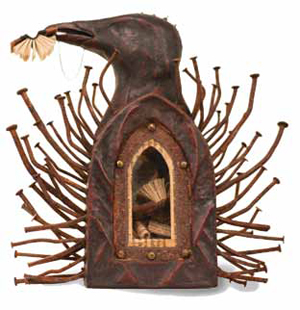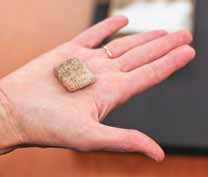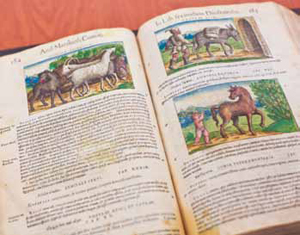
Bower Bird by Daniel Essig, 2009, sculpture with miniature books and nails, made of mahogany, handmade paper, milk, paints, and nails. |
Beth Remak-Honnef was at her job as head of the University Library's Special Collections & Archives at UC Santa Cruz when a student asked to see her.
"My professor said you could show me something awesome," he told her.
Remak-Honnef, used to obscure requests from scholars and authors, didn't hesitate.
She brought out a 19th century illustrated version of Goethe's Faust that promptly blew the young man's mind.
If you can't make it to Special Collections, here are 10 "awesome" artifacts that just might blow your own mind.

4,000-year-old cuneiform tablet |
1. A 4,000-year-old cuneiform tablet. Sepia-toned and slightly bigger than a stamp, the tablet is an ancient shopping list for beer, barley, and onions.
2. A globe of the planet Mars. This globe was owned by renowned sci-fi author Robert Heinlein, who collected planetary and sky globes.
3. A painting that is really a letter. Expressionist artist Morris Graves sent a tempera-on-paper painting to composer John Cage featuring mushrooms and the note "Dear John: Yum, Yum." It's part of Cage's extensive mycology collection now held at UCSC.

1554 illustrated book of veggies and herbs (photos by Carolyn Lagattuta) |
4. A book in a can. Peter and Donna Thomas, noted fine book artists, created an illustrated excerpt of John Steinbeck's Cannery Row, and presented it in a tin can. Peter studied book arts with the poet William Everson and graduated from UCSC in 1978.
5. A 400-year-old astrology chart. Prepared by noted astronomer Johannes Kepler for Austrian nobleman Hans Hannibal Hutter von Hutterhofen, this astrological chart may have either been done for extra cash or as part of Kepler's duties as court mathematician.

Book in a can (photo by James MacKenzie) |
6. A book of herbs, vegetables, bugs, and farm animals. Printed in Venice in 1554 and lavishly illustrated with over 600 hand-colored woodcuts, this tome by Pietro Andrea Mattioli was likely owned by someone who wished to impress visitors. It was recently purchased using funds donated by local community members.
|
TRANSFORMATIVE EDUCATION: An extraordinary undergraduate experience develops highly engaged citizens and effective leaders. UCSC's college communities offer opportunities for hands-on learning and a sense of community, fostering high levels of student engagement and personal growth. Students learn to challenge the expected, ask the big questions, and be active partners in learning and in life. |
7. Portrait of astronomer William Wallace Campbell. UCSC has one of the best collections of astronomer portraits in the world. Many of them are old cabinet cards (like calling cards), handed out by these scientists and held in the Lick Observatory archives housed in Special Collections. Campbell went on to become the University of California's 10th president.
8. A ship's porthole. Antinuclear activist Earle Reynolds, the son of a family of trapeze artists, left boxes of maps, photos, and memorabilia to UCSC. Reynolds was best known for sailing his family into a nuclear test zone in the Pacific in protest of those activities. Some of his materials had to be tested for radioactivity before they were accepted in the collection.
9. Portrait of Kathleen Cleaver. Cleaver, now a lecturer at Yale, was formerly married to early Black Panther leader Eldridge Cleaver and is known for her involvement with the Black Panther Party. Pirkle Jones and Ruth-Marion Baruch's landmark 1968 photographs of members of the Black Panther Party were donated to UCSC in 2003. Their collection, estimated to be worth $1 million, also includes documentation of the fates of old California towns and the Summer of Love in the Haight-Ashbury.
10. Photograph of the Czar's golden tableware. Taken in the Kremlin in 1931, this picture is one of 8,000 hand-tinted lantern slides from the collection of photographer Branson DeCou. Much of his work, including shots of old Cuba and Ireland, has been digitized and is available for viewing online.
With rooms full of photographs, documents, books, and art, UCSC's Special Collections offers access to the library's most unique holdings for educational, private study, and research purposes.
It collects, organizes, describes, preserves, and promotes collections that hold particular historical and cultural significance; houses and provides access to publications and archives focusing on the geographic region of Santa Cruz; and serves as the repository for UCSC administrative archives and records.
It is the home of the Grateful Dead Archive, contains the largest holding of Edward Weston photographs in the country, and houses the complete archive of Hugo Award–winning science fiction writer Heinlein—author of Stranger in a Strange Land, Starship Troopers, and other classics.


